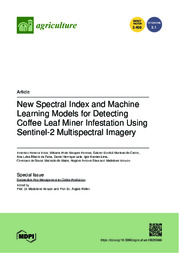New spectral index and machine learning models for detecting coffee leaf miner infestation using sentinel-2 multispectral imagery.
New spectral index and machine learning models for detecting coffee leaf miner infestation using sentinel-2 multispectral imagery.
Resumo: The coffee leaf miner (Leucoptera coffeella) is a key coffee pest in Brazil that can cause severe defoliation and a negative impact on the productivity. Thus, it is essential to identify initial pest infestation for the sake of appropriate time control to avoid further economic damage to the coffee crops. A fast non-destructive method is an important tool that can be used to monitor the occurrence of the coffee leaf miner. The present work aims to identify the occurrence of coffee leaf miner infestation through a new vegetation index, using multispectral images from the Sentinel-2 satellite and the Google Earth Engine platform. Coffee leaf miner infestation was measured in the field in four cities in the state of Minas Gerais. The largest infestations occurred in September, October, and November but particularly in October 2021, in which the rate of infestation reached 85%, followed by September 2020 with a maximum infestation of 76%. The calculation steps of the vegetation indices and mappings were carried out in the Google Earth Engine cloud processing platform through the development of a script in JavaScript programming language. Combinations of two sensitive bands were selected to detect coffee leaf miner infestation, and from these, the 'Coffee-Leaf-Miner Index' was developed, which was compared with other existing vegetation indices in terms of their performance for coffee leaf miner detection. The combination of the NIR-BLUE and NIR-RED bands was more sensitive for the detection of coffee leaf miner infestation; therefore, the NIR, BLUE, and RED bands were selected to develop the new index. The 'Coffee-Leaf-Miner Index' presented the best performance among those evaluated, with a coefficient of determination of about 0.87, a root mean square error of 4.92% coffee leaf miner infestation, accuracy of 89.47%, and kappa coefficient of 95.39. The R2 range of other spectral indices which exist in the literature and which were used in this study was from 0.017 to 0.867, and the root mean square error ranged from 4.996 to 13.582% coffee leaf miner infestation. The machine learning method was then adopted using the supervised Random Forest and Support Vector Machine algorithms to recognize patterns of coffee leaf miner infestation in the field, only the Coffee-Leaf-Miner Index was used for the identification test of the coffee leaf miner infestation. The Support Vector Machine with linear Kernel type was applied to establish a discrimination model. The number of trees for the Random Forest classifier was 100. The Support Vector Machine presented a lower performance than the Random Forest algorithm, but the performance of both were above 80% for user and producer precision. Three bands (Blue, Red, NIR) were selected for the creation of the new index, which showed capacity for remote detection of coffee leaf miner infestation on a regional scale. Thus, 'Coffee-Leaf-Miner Index' can identify coffee leaf miner infestation thanks to all the complexity involved in detecting pests via orbital remote sensing.
Ano de publicação: 2023
Tipo de publicação: Artigo de periódico
Unidade: Embrapa Café
Observações
1 - Por padrão são exibidas publicações dos últimos 20 anos. Para encontrar publicações mais antigas, configure o filtro ano de publicação, colocando o ano a partir do qual você deseja encontrar publicações. O filtro está na coluna da esquerda na busca acima.
2 - Para ler algumas publicações da Embrapa (apenas as que estão em formato ePub), é necessário ter, no celular ou computador, um desses softwares gratuitos. Sistemas Android: Google Play Livros; IOS: iBooks; Windows e Linux: software Calibre.
Acesse outras publicações
Acesse a Base de Dados da Pesquisa Agropecuária (BDPA) para consultar o acervo completo das bibliotecas da Embrapa.

